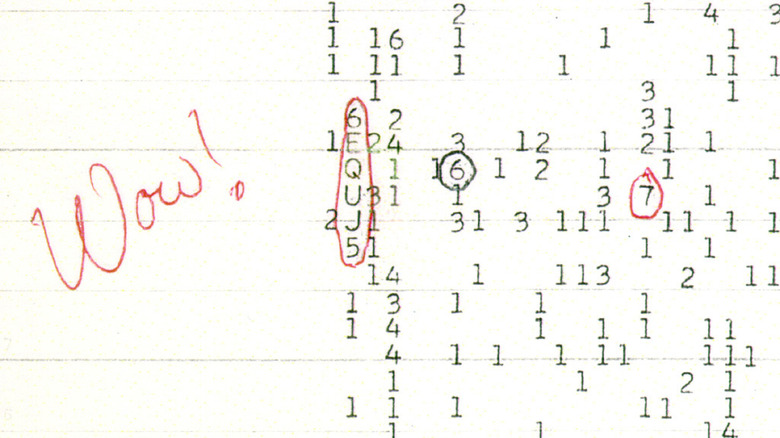
The Truth About The Mysterious ‘Wow! Signal’
The search for extraterrestrial life remains a driving desire for humanity — fueled by our own fictions, promising technologies, and perhaps the wish to pass along the self-awareness baton to another species (and get off the hook for ruining our planet). Of course, as “Ancient Aliens” mascot Giorgio A. Tsoukalos would say (you know, the meme guy), maybe we already were visited by aliens in the distant past, and these celestial progenitors mucked around with our DNA before scampering off.
But sorry, “Star Trek” fans, if we were ever to meet an alien civilization, it likely wouldn’t be in starships gallivanting across the cosmos like 16th-century maritime pioneers. There are 4,389 exoplanets in the Milky Way, give or take (per NASA), connected to 100 billion stars, but the size of the galaxy — 100,000 light years across — makes it practically impossible to traverse barring faster-than-light travel. And beyond our galaxy? Just remember that our vision of the night sky is a vision of the past. The Andromeda Galaxy is 2.5 million light years away, again per NASA. If we set out today in a light-speed ship, what are the odds of a sentient, language-using, civilization-creating, similarly evolved and communicative species still existing by the time we got there, 2.5 million years later?
All in all, it’s most likely that our first alien contact would be through something that seems drab compared to Klingons or Area 51 gray aliens: signals. As it turns out, though, it might have already happened.
A 1977 signal from Sagittarius never spotted again
The SETI (Search for Extraterrestrial Intelligence) Institute is easily the most well-known observatory for alien life. Since being founded in 1984, they’ve grown from a two-person NASA offshoot project to a 100-employee, multidisciplinary education-and-research center overseen by trustees as such as astronomical titans Carl Sagan and Frank Drake, as the SETI website explains. Their search focuses on “narrow-band signals,” which use only “a small part of the radio spectrum” — a few hertz wide or less — produced by artificial transmitters, per the SETI FAQ. Natural celestial bodies such as large gaseous bodies, pulsars, quasars, and the like don’t generate these kinds of wavelengths.
Back in the summer of 1977, though, it wasn’t the SETI Institute prowling the skies in search of alien life. It was volunteers and nigh-broke university staff at the Big Ear Radio Observatory at Ohio State University. The observatory was a strange, unconventionally built, sky-mapping array constructed in the late 1960s on a “shoestring budget,” as former volunteer Jerry Ehman told Astronomy Magazine. Ehman was the one who sat down on August 17 to review data collected from the previous few days; just another volunteer session. What he discovered, though — a super strong signal from the constellation Sagittarius — stunned him so much that he circled his printout in red and wrote “Wow!” (above). Hence the moniker of the now-infamous, still-unexplained “Wow! Signal.”
The 72-second long signal read “6EQUJ5,” indicating it started low, gained in strength, and then dropped off again. It was artificial, not from Earth, and has never been rediscovered.
New stellar detectives and new theories
Big Ear was shuttered in 1998, but that hasn’t stopped folks from trying to get to the bottom of the Wow! Signal. In 2013, as EarthSky explains, the European Space Agency (ESA) launched its Gaia program to render the most thorough 3D star map of our galaxy, ever (check it out online). It checks not only positioning of stars, but movement, scanning billions of stars dozens of times each. Its 1.3 billion star catalog will be finished in 2024.
Gaia was enough to inspire Alberto Caballero, an amateur astronomer and creator of the exoplanet exploration YouTube channel “The Exoplanets Channel,” who’s made actual headway in pinpointing and defining the Wow! Signal. Caballero told Discover Magazine, “The only potential Sun-like star in all the WOW! Signal region appears to be 2MASS 19281982-2640123. This star sits in the constellation of Sagittarius at a distance of 1,800 light-years. It is an identical twin to our Sun, with the same temperature, radius, and luminosity.” Caballero’s found 66 other candidates as well, but all with weaker evidence.
Unfortunately, three years earlier, in 2017, Antonio Paris, adjunct professor of astronomy at St. Petersburg College and ex-analyst with Department of Defense (DoD), came forward and stated that two comets, 266P/Christensen (online at NASA) and P/2008 Y2 (Gibbs) (also online at NASA), most likely generated the Wow! Signal. Per EarthSky, the comets were passing through the region of the sky being surveyed by the Big Ear Radio Observatory on August 15, 1977.
A candidate signal from Proxima Centauri
Back when the Wow! Signal was first recorded, as EarthSky explains, Big Ear director John Kraus wrote Carl Sagan and said, “The Wow! signal is highly suggestive of extraterrestrial intelligent origin, but little more can be said until it returns for further study.” Years of further study haven’t provided anything conclusive, though, not even the “it was comets” theory, to which astronomer Seth Shostak at the SETI Institute simply replied, “I don’t think anyone ever found such emission from comets.”
Newer signals have been detected since the Wow! days, though, such as the “best candidate for an extraterrestrial message in 42 years” from our closest star neighbor, Proxima Centauri, a red dwarf 4.25 light-years away. On December 18, 2020, The Guardian reported on a leaked story that made its way to them from the Parkes radio telescope in Australia. The only problem? As Astronomy says, it’s “99.9 percent likely to be human radio interference.” Besides, Proxima Centauri b, the system’s Earth-like exoplanet, is probably devoid of life because the planet is continually thrashed by intense solar rays, as Forbes explains.
Of course, all data will likely prove inconclusive until ET shows up at someone’s back door, knocking to come inside and borrow a phone. Only then, at the end of that alien’s long, probing fingertips, will we have a remedy for the notion that the only beings trying to live long and prosper in the great, big cosmos would be us.

Here's Who Inherited Bob Marley's Fortune After His Death

Here's How JFK Faked His Way Into The Navy

The Untold Truth Of Emperor Akihito

The Truth About The Pagans Outlaw Motorcycle Gang's Secret Drug Ring

The Truth About Abigail In The Bible

The Unexpected Heir To Pablo Escobar's Drug Cartel

This Is The Difference Between A Coffin And A Casket

These Are Ozzy Osbourne's Three Biggest Regrets

The Tiny Toons Episode That Caused An Outrage

The Top Halloween Costume The Year You Were Born


























